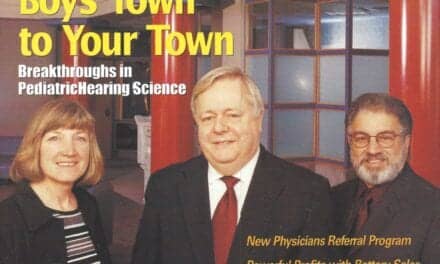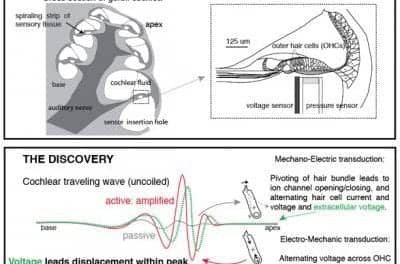Summary:
Despite major advances in cochlear implant technology and broader candidacy criteria, breaking down access barriers has been a slow and uneven process. Candidacy has steadily evolved, but systemic challenges have persisted, prompting professionals to find new ways to close the gap in care.
Three Key Takeaways:
- Expanded Candidacy and FDA Approvals: Cochlear implants are now approved for broader populations, including patients with single-sided deafness (SSD) and younger children, though experts argue current age thresholds could still be lowered to improve outcomes.
- Policy Progress with Persistent Gaps: Recent changes, such as Medicare’s updated speech recognition criteria, have improved access, but limitations remain—especially for SSD patients and those facing insurance-based restrictions.
- Referral and Awareness Challenges: Tools like the 60/60 guideline help clinicians identify candidates, but inconsistent application and outdated perceptions about cochlear implants continue to prevent many eligible individuals from receiving care.
Understanding cochlear implants today means recognizing how far technology and access have come, and how far they still need to go. Despite decades of innovation and expanded candidacy criteria, fewer than 10% of eligible individuals in the United States have received a cochlear implant, underscoring the persistent gaps in awareness, coverage, and care.1
We now live in an era where hearing loss solutions are more advanced and widely available than ever. But cochlear implant (CI) access in the U.S. remains a work in progress, and is shaped by decades of evolving clinical criteria, regulatory changes, and disparities in coverage.
New Indications, New Opportunities for SSD Patients
One example that can reflect this dichotomy is the recent expansion of FDA-approved cochlear implant indications to include patients with single-sided deafness (SSD), a milestone that, not long ago, was considered outside the bounds of candidacy.
In 2019, Med-El received U.S. FDA approval for its cochlear implant systems, Synchrony and Synchrony 2, making them the first devices officially indicated for patients aged five and older with single-sided deafness (SSD) or asymmetric hearing loss (AHL). A few years later, in 2022, Cochlear Americas received FDA approval for CI indication for its Nucleus 24 Cochlear Implant System for patients (also for patients five and older) with severe to profound hearing loss in one ear (SSD/unilateral hearing loss) with normal hearing in the other as well as for traditional candidacy.
Before these approvals for CI indication (i.e. candidacy criteria), cochlear implants were sometimes used “off-label” to treat SSD, with clinicians recommending CIs for patients outside the scope of FDA-approved criteria when the potential benefits for the patient outweighed the risks.2 These off-label uses played a significant role in building the case for official recognition by the FDA in 2019 and 2022.3 Despite earlier studies demonstrating the benefits of CIs for SSD 4-5, it took time for regulatory frameworks to catch up.
Establishing an official pathway to cochlear implants for SSD patients marks a significant step forward, but some may say the progress has its own limitations. Some experts argue that the current minimum age requirement is still too high.
“I do think SSD criteria, even though it’s at five years, which sounds young, could be lower,” says Melissa Hall, MA, AuD, CCC-A/SLP, audiologist and Cochlear Implant Team Audiology Coordinator at University of Florida Health. “So in terms of neural plasticity, that expansion should be much lower and there’s research to indicate as low as two years, if not lower than that. I do feel like that is a sticking point where we could have better outcomes with a pediatric patient who has single-sided deafness if we’re able to implant younger.”
Room to Grow for Pediatric Implantation
Indeed, pediatric cochlear implant indications have traditionally advanced more slowly than those for adults.
While CIs were approved for adults in the 1980s, pediatric patients had to wait until 1990, when the Cochlear Nucleus Implant became the first cochlear implant to be approved by the FDA for use in children with profound hearing loss, but only for those aged 2 years and older. The minimum age was later lowered to 18 months in 1998, then to 12 months in 2000, and most recently to 9 months in 2020.
Still, similar to the age restrictions for SSD candidacy, some professionals believe the minimum age for pediatric cochlear implantation could safely be lowered to 6 months. At the heart of this conversation is the need to balance surgical and anesthesia safety with the developmental advantages of earlier auditory access.
Allison Biever, AuD, CCC-A, audiologist at Rocky Mountain Ear Center, notes that while the current FDA-approved minimum age is 9 months, there’s increasing interest in the possibility of implanting profoundly deaf infants even earlier.
“When I talk with surgeons about the risks of anesthesia, [they say] the risks go down when a child is about 6 months of age,” Biever says.
Breaking Barriers for Medicare
In parallel with the arrested development of pediatric CI candidacy criteria, older adults, in particular those on Medicare, have faced their own set of systemic obstacles when it comes to accessing cochlear implants.
Meeting cochlear implant candidacy criteria will vary depending on a patient’s insurance coverage. But those on Medicare had, until recently, more restrictive criteria than individuals with private insurance.
For example, just a few years ago Medicare would only cover cochlear implants for patients with sentence recognition scores of 40% or under in the best-aided condition. This excluded many older adults who could still benefit from a CI but performed slightly better than that threshold on standard speech recognition tests.
That changed in September 2022, when the Centers for Medicare & Medicaid Services (CMS) revised its national coverage determination for cochlear implantation. The update expanded eligibility by raising the sentence recognition score threshold from 40% to 60% in the best-aided condition, bringing Medicare’s coverage criteria more in line with those from private insurers and the FDA.
“Before this changed, some of my patients would say, ‘This seems like age discrimination,’” Biever says. “But Medicare is a federally funded insurance program, and that was their cutoff. You had to perform 40% or poorer on a sentence task. And yet, if you were 64 years old and on another insurance program, you could be allowed to get up to 60% of the sentences correct and qualify.”
Despite this notable instance of progress, gaps in Medicare coverage persist. For example, individuals with single-sided deafness are not eligible for cochlear implants under current Medicare guidelines, leaving out an entire population of potential beneficiaries.
Bridging the Referral Gap: The 60/60 Guideline
While the recent Medicare update has helped standardize a critical area for candidacy coverage, vagueness permeates elsewhere as there’s still no universally accepted protocol for using routine, office-based audiometry to determine who qualifies for a cochlear implant.2 This lack of clarity has left many audiologists uncertain about when to refer patients for further evaluation.
To address this gap, several researchers have proposed tools to help guide referrals and predict cochlear implant candidacy. This includes the guidelines the American Cochlear Implant Alliance developed for determining CI candidacy in children and adults, which is available at https://www.acialliance.org/page/DeterminingCICandidacy But one of the most widely adopted tools is the “60/60 guideline,” developed by Teresa “Terry” Zwolan, PhD, CCC-A, director of Medical Affairs at Cochlear.
The guideline Development of a 60/60 Guideline for Referring Adults for a Traditional Cochlear Implant Candidacy Evaluation recommends audiologists refer patients for a CI evaluation if they have a monosyllabic word recognition score of 60% or less in their best ear, along with an unaided pure-tone average in the better ear of 60 dB HL or greater.
Zwolan says the need for such a tool became clear as she observed clinicians struggle with identifying potential CI candidates without specific indications to follow.
“All audiologists know how to do an audiogram, and audiometric testing is considered the standard of care in audiology,” says Zwolan. “So, hopefully, they could identify a person who might be an implant candidate based on what they read on the audiogram and say, ‘Let’s send them on for an evaluation.’ A lot of clinics have adopted the 60/60 guideline, and I’m personally thrilled that people have found it very helpful.”
Evolving Mindsets about CI
While the 60/60 referral guideline has been widely adopted in the audiology community, its rollout has also underscored the need for consistent alignment and education. Some professionals argue that even the “60/60 guideline” threshold is either too lenient or too strict, prompting ongoing discussions around best practices.
Zwolan emphasizes the importance of consistency across the field. “I think we’re better aligned than ever before, but I think we could still do some more work,” she says.
Establishing a stronger consensus around candidacy criteria could help address persistent disparities in access. Despite technological advancements and broader indications, the cochlear implant system still fails to reach the majority of those who qualify. A national study conducted in 2021 estimated that fewer than 10% of eligible individuals in the U.S. have actually received a cochlear implant.
Greater integration across different audiological sectors may be one way to close this gap and expand access to cochlear implants. Several professionals point to the importance of embracing treatment options like bimodal hearing (getting support from a hearing aid in one ear and a cochlear implant in the other) and challenging the outdated perception of cochlear implants as a “last resort.”
“We shouldn’t consider cochlear implants as a last resort because there are so many other uses to them that they’ve been demonstrated to be very successful with a lot of different degrees of hearing loss and different needs from a language development perspective,” says Hall. “We should think of it more as a continuation of care and be more fluid with how we see ourselves as providers so that we don’t hold our patients back from their best options for care.”
Shifting perceptions may also come with the next wave of innovation. As new technologies, including fully implantable cochlear implants, move through clinical trials, experts expect these devices to further normalize the use of hearing technology.
“When we realize a solution that is totally implantable and doesn’t require any visual piece on the outside, I can only imagine that that is going to grow cochlear implants, grow that field and increase our penetration rate,” says Allison Racey, AuD, VP of clinical research, Med-El Corp. “I think we’ve come a long way in terms of that being one of the barriers to getting any kind of hearing device, whether that’s a hearing aid or a cochlear implant.”
Andy Lundin is a freelance writer and editor specializing in healthcare content, with experience in feature writing across the hearing healthcare, clinical diagnostics, and medical device industries.
Featured image: ID 52860454 © Monkey Business Images | Dreamstime.com
References
- Marinelli JP, Sydlowski SA, Carlson ML. Cochlear implant awareness in the United States: a national survey of 15,138 adults. Seminars in Hearing. 2022;43(04):317-323. doi:10.1055/s-0042-1758376
- Zeitler DM, Prentiss SM, Sydlowski SA, Dunn CC. American Cochlear Implant Alliance Task Force: Recommendations for Determining Cochlear Implant Candidacy in adults. The Laryngoscope. 2023;134(S3). doi:10.1002/lary.30879
- Biever A, Kelsall DC, Lupo JE, Haase GM. Evolution of the candidacy requirements and patient perioperative assessment protocols for cochlear implantation. The Journal of the Acoustical Society of America. 2022;152(6):3346-3359. doi:10.1121/10.0016446
- Van De Heyning P, Vermeire K, Diebl M, Nopp P, Anderson I, De Ridder D. Incapacitating unilateral tinnitus in Single-Sided deafness treated by cochlear implantation. Annals of Otology Rhinology & Laryngology. 2008;117(9):645-652. doi:10.1177/000348940811700903
- Kamal SM, Robinson AD, Diaz RC. Cochlear implantation in single-sided deafness for enhancement of sound localization and speech perception. Current Opinion in Otolaryngology & Head & Neck Surgery. 2012;20(5):393-397. doi:10.1097/moo.0b013e328357a613





